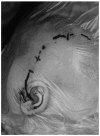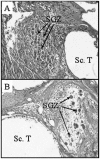Biomaterials in cochlear implants
- PMID: 22073103
- PMCID: PMC3199815
- DOI: 10.3205/cto000062
Biomaterials in cochlear implants
Abstract
The cochlear implant (CI) represents, for almost 25 years now, the gold standard in the treatment of children born deaf and for postlingually deafened adults. These devices thus constitute the greatest success story in the field of 'neurobionic' prostheses. Their (now routine) fitting in adults, and especially in young children and even babies, places exacting demands on these implants, particularly with regard to the biocompatibility of a CI's surface components. Furthermore, certain parts of the implant face considerable mechanical challenges, such as the need for the electrode array to be flexible and resistant to breakage, and for the implant casing to be able to withstand external forces.As these implants are in the immediate vicinity of the middle-ear mucosa and of the junction to the perilymph of the cochlea, the risk exists - at least in principle - that bacteria may spread along the electrode array into the cochlea. The wide-ranging requirements made of the CI in terms of biocompatibility and the electrode mechanism mean that there is still further scope - despite the fact that CIs are already technically highly sophisticated - for ongoing improvements to the properties of these implants and their constituent materials, thus enhancing the effectiveness of these devices.This paper will therefore discuss fundamental material aspects of CIs as well as the potential for their future development.
Keywords: biocompatibility; biomaterials; coating; cochlear implant; cochleostomy; drug delivery; electrode; inner ear; nanoparticles; surface functionalization.
Figures






















Similar articles
-
[Biomaterials in cochlear implants].Laryngorhinootologie. 2009 May;88 Suppl 1:S12-31. doi: 10.1055/s-0028-1119552. Epub 2009 Apr 7. Laryngorhinootologie. 2009. PMID: 19353453 Review. German.
-
Improved auditory performance of cochlear implant patients using the middle fossa approach.Audiology. 1999 Jul-Aug;38(4):225-34. doi: 10.3109/00206099909073026. Audiology. 1999. PMID: 10431908
-
New window for cochlear implant insertion.Acta Otolaryngol. 1999 Mar;119(2):214-8. doi: 10.1080/00016489950181693. Acta Otolaryngol. 1999. PMID: 10320079
-
The Effect of Round Window vs Cochleostomy Surgical Approaches on Cochlear Implant Electrode Position: A Flat-Panel Computed Tomography Study.JAMA Otolaryngol Head Neck Surg. 2016 Sep 1;142(9):873-80. doi: 10.1001/jamaoto.2016.1512. JAMA Otolaryngol Head Neck Surg. 2016. PMID: 27355198
-
Congenital malformations of the ear and cochlear implantation in children: review and temporal bone report of common cavity.J Laryngol Otol Suppl. 2000;25:1-14. doi: 10.1258/0022215001904842. J Laryngol Otol Suppl. 2000. PMID: 10824232 Review.
Cited by
-
Antibacterial Designs for Implantable Medical Devices: Evolutions and Challenges.J Funct Biomater. 2022 Jun 21;13(3):86. doi: 10.3390/jfb13030086. J Funct Biomater. 2022. PMID: 35893454 Free PMC article. Review.
-
Biopolymeric Coatings for Local Release of Therapeutics from Biomedical Implants.Adv Sci (Weinh). 2023 Apr;10(12):e2207603. doi: 10.1002/advs.202207603. Epub 2023 Feb 13. Adv Sci (Weinh). 2023. PMID: 36782094 Free PMC article. Review.
-
On the Fabrication and Characterization of Polymer-Based Waveguide Probes for Use in Future Optical Cochlear Implants.Materials (Basel). 2022 Dec 22;16(1):106. doi: 10.3390/ma16010106. Materials (Basel). 2022. PMID: 36614443 Free PMC article.
-
Cochlear implant - state of the art.GMS Curr Top Otorhinolaryngol Head Neck Surg. 2018 Feb 19;16:Doc04. doi: 10.3205/cto000143. eCollection 2017. GMS Curr Top Otorhinolaryngol Head Neck Surg. 2018. PMID: 29503669 Free PMC article. Review.
-
Direct Intracochlear Acoustic Stimulation Using a PZT Microactuator.Trends Hear. 2015 Dec 1;19:2331216515616942. doi: 10.1177/2331216515616942. Trends Hear. 2015. PMID: 26631107 Free PMC article.
References
-
- Burgio P. Safety considerations of cochlear implantation. Otolaryngol Clin North Am. 1986;19(2):237–247. - PubMed
-
- Lehnhardt E. Biokompatibilität der Cochlear-implants. Eur Arch Otorhinolaryngol Suppl. 1992;1:223–233. - PubMed
-
- BQS Qualitätsreport. Düsseldorf: BQS Institut für Qualität und Patientensicherheit; 2007. p. 36. Available from: http://www.bqs-qualitaetsreport.de/
-
- Dunn CC, Tyler RS, Oakley S, Gantz BJ, Noble W. Comparison of speech recognition and localization performance in bilateral and unilateral cochlear implant users matched on duration of deafness and age at implantation. Ear Hear. 2008;29(3):352–359. doi: 10.1097/AUD.0b013e318167b870. Available from: http://dx.doi.org/10.1097/AUD.0b013e318167b870. - DOI - DOI - PMC - PubMed
-
- O'Donoghue GM, Nikolopoulos TP. Minimal access surgery for pediatric cochlear implantation. Otol Neurotol. 2002;23(6):891–894. doi: 10.1097/00129492-200211000-00014. Available from: http://dx.doi.org/10.1097/00129492-200211000-00014. - DOI - DOI - PubMed
LinkOut - more resources
Full Text Sources
Other Literature Sources

